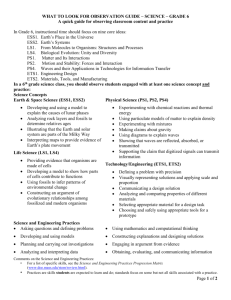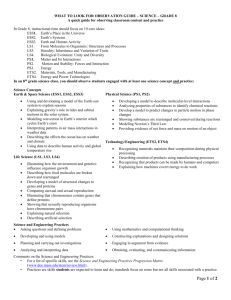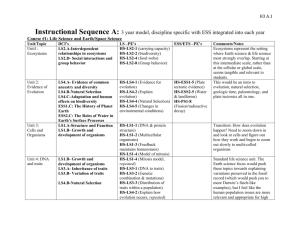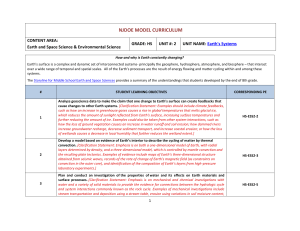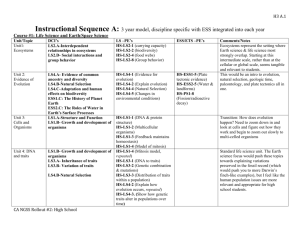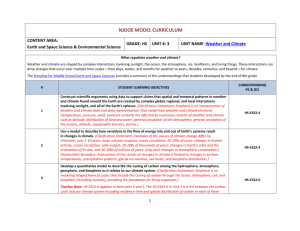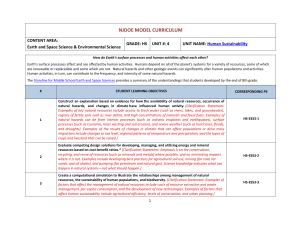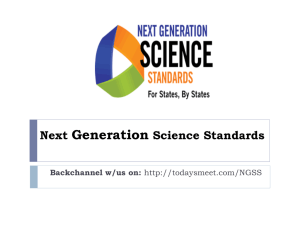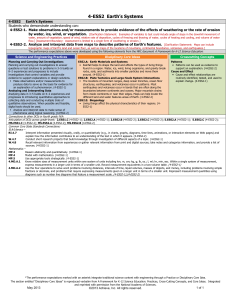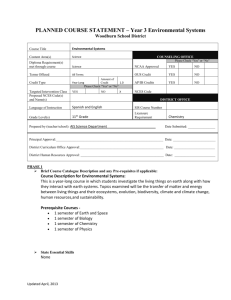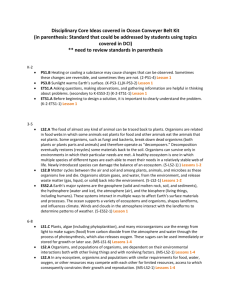Word - State of New Jersey
advertisement
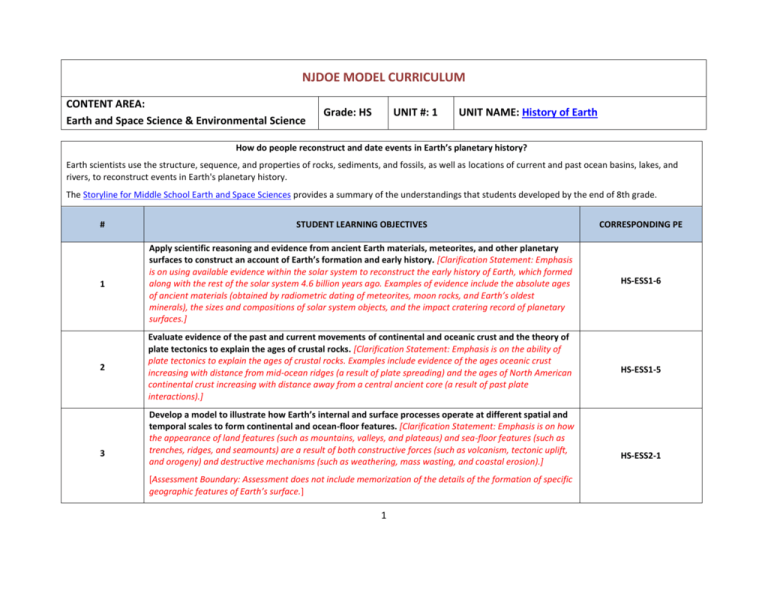
NJDOE MODEL CURRICULUM CONTENT AREA: Earth and Space Science & Environmental Science Grade: HS UNIT #: 1 UNIT NAME: History of Earth How do people reconstruct and date events in Earth’s planetary history? Earth scientists use the structure, sequence, and properties of rocks, sediments, and fossils, as well as locations of current and past ocean basins, lakes, and rivers, to reconstruct events in Earth's planetary history. The Storyline for Middle School Earth and Space Sciences provides a summary of the understandings that students developed by the end of 8th grade. # STUDENT LEARNING OBJECTIVES CORRESPONDING PE 1 Apply scientific reasoning and evidence from ancient Earth materials, meteorites, and other planetary surfaces to construct an account of Earth’s formation and early history. [Clarification Statement: Emphasis is on using available evidence within the solar system to reconstruct the early history of Earth, which formed along with the rest of the solar system 4.6 billion years ago. Examples of evidence include the absolute ages of ancient materials (obtained by radiometric dating of meteorites, moon rocks, and Earth’s oldest minerals), the sizes and compositions of solar system objects, and the impact cratering record of planetary surfaces.] HS-ESS1-6 2 Evaluate evidence of the past and current movements of continental and oceanic crust and the theory of plate tectonics to explain the ages of crustal rocks. [Clarification Statement: Emphasis is on the ability of plate tectonics to explain the ages of crustal rocks. Examples include evidence of the ages oceanic crust increasing with distance from mid-ocean ridges (a result of plate spreading) and the ages of North American continental crust increasing with distance away from a central ancient core (a result of past plate interactions).] HS-ESS1-5 3 Develop a model to illustrate how Earth’s internal and surface processes operate at different spatial and temporal scales to form continental and ocean-floor features. [Clarification Statement: Emphasis is on how the appearance of land features (such as mountains, valleys, and plateaus) and sea-floor features (such as trenches, ridges, and seamounts) are a result of both constructive forces (such as volcanism, tectonic uplift, and orogeny) and destructive mechanisms (such as weathering, mass wasting, and coastal erosion).] [Assessment Boundary: Assessment does not include memorization of the details of the formation of specific geographic features of Earth’s surface.] 1 HS-ESS2-1 NJDOE MODEL CURRICULUM CONTENT AREA: Earth and Space Science & Environmental Science 4 Grade: HS UNIT #: 1 UNIT NAME: History of Earth Construct an argument based on evidence about the simultaneous coevolution of Earth's systems and life on Earth. [Clarification Statement: Emphasis is on the dynamic causes, effects, and feedbacks between the biosphere and Earth’s other systems, whereby geoscience factors control the evolution of life, which in turn continuously alters Earth’s surface. Examples of include how photosynthetic life altered the atmosphere through the production of oxygen, which in turn increased weathering rates and allowed for the evolution of animal life; how microbial life on land increased the formation of soil, which in turn allowed for the evolution of land plants; or how the evolution of corals created reefs that altered patterns of erosion and deposition along coastlines and provided habitats for the evolution of new life forms.] HS-ESS2-7 [Assessment Boundary: Assessment does not include a comprehensive understanding of the mechanisms of how the biosphere interacts with all of Earth’s other systems.] Teacher Note: This PE is used in both units 1 and 2. The emphasis of the PE is slightly different in each unit. The focus of HS-ESS2-7 in Unit 1 is on the how the diversity of organisms found in our fossil evidence as recorded over geologic time provides evidence for changing environments. The focus HS-ESS2-7 in Unit 2 is on how the chemical changes in the various Earth Systems have lead to the evolution of life over time. 5 Evaluate the evidence supporting claims that changes in environmental conditions may result in: (1) increases in the number of individuals of some species, (2) the emergence of new species over time, and (3) the extinction of other species. [Clarification Statement: Emphasis is on determining cause and effect relationships for how changes to the environment such as deforestation, fishing, application of fertilizers, drought, flood, and the rate of change of the environment affect distribution or disappearance of traits in Teacher Note: Within this unit the focus of this SLO is on the relationship of various life forms found in the fossil record over geologic time and the environmental conditions within the Earth system which may have precipitated the changes in life forms. 2 HS-LS4-5 NJDOE MODEL CURRICULUM CONTENT AREA: Earth and Space Science & Environmental Science Grade: HS UNIT #: 1 UNIT NAME: History of Earth The performance expectations above were developed using the following elements from the NRC document A Framework for K-12 Science Education: Science and Engineering Practices Developing and Using Models (pp. 56-59) Students use, synthesize, and develop models to predict and show relationships among variables between systems and their components in the natural and designed worlds. Develop a model based on evidence to illustrate the relationships between systems or between components of a system. (HS-ESS2-1) Constructing Explanations and Designing Solutions (pp. 67-71) Students construct explanations and design solutions that are supported by multiple and independent student-generated sources of evidence consistent with scientific ideas, principles, and theories. Apply scientific reasoning to link evidence to the claims to assess the extent to which the reasoning and data support the explanation or conclusion. (HS-ESS1-6) Engaging in Argument from Evidence (pp. 71-74) Students use appropriate and sufficient evidence and scientific reasoning to defend and critique claims and explanations about the natural and designed world(s). Arguments may also come from Disciplinary Core Ideas ESS1.C: The History of Planet Earth (pp. 177-179) Continental rocks, which can be older than 4 billion years, are generally much older than the rocks of the ocean floor, which are less than 200 million years old. (HS-ESS1-5) Although active geologic processes, such as plate tectonics and erosion, have destroyed or altered most of the very early rock record on Earth, other objects in the solar system, such as lunar rocks, asteroids, and meteorites, have changed little over billions of years. Studying these objects can provide information about Earth’s formation and early history. (HS-ESS1-6) Crosscutting Concepts Patterns (pp. 85-87) Empirical evidence is needed to identify patterns. (HS-ESS1-5) ESS2.A: Earth Materials and Systems (pp. 179-182) Earth’s systems, being dynamic and interacting, cause feedback effects that can increase or decrease the original changes. (HS-ESS2-1), (Note: This Disciplinary Core Idea is also addressed by HS-ESS22.) Cause and Effect (pp. 87-89) Empirical evidence is required to differentiate between cause and correlation and make claims about specific causes and effects. (HS-LS4-5) ESS2.B: Plate Tectonics and Large-Scale System Interactions (pp. 182-183) Plate tectonics is the unifying theory that explains the past and current movements of the rocks at Earth’s surface and provides a framework for 3 Stability and Change (pp. 98-101) Much of science deals with constructing explanations of how things change and how they remain stable. (HS-ESS1-6), (HSESS2-7) Change and rates of change can be quantified and modeled over very short or very long periods of time. Some system changes are irreversible. (HS-ESS2-1) NJDOE MODEL CURRICULUM CONTENT AREA: Earth and Space Science & Environmental Science current scientific or historical episodes in science. Evaluate evidence behind currently accepted explanations or solutions to determine the merits of arguments. (HS-ESS1-5), (HS-ESS2-7), (HS-LS4-5) -----------------------------------Connections to Nature of Science Science Models, Laws, Mechanisms, and Theories Explain Natural Phenomena A scientific theory is a substantiated explanation of some aspect of the natural world, based on a body of facts that have been repeatedly confirmed through observation and experiment and the science community validates each theory before it is accepted. If new evidence is discovered that the theory does not accommodate, the theory is generally modified in light of this new evidence. (HS-ESS1-6) Models, mechanisms, and explanations collectively serve as tools in the development of a scientific theory. (HS-ESS1-6) Grade: HS UNIT #: 1 UNIT NAME: History of Earth understanding its geologic history. (ESS2.B Grade 8 GBE) (secondary to HS-ESS1-5),(HS-ESS2-1) Plate movements are responsible for most continental and ocean-floor features and for the distribution of most rocks and minerals within Earth’s crust. (ESS2.B Grade 8 GBE) (HS-ESS2-1) ESS2.D: Weather and Climate (pp. 186-189) Gradual atmospheric changes were due to plants and other organisms that captured carbon dioxide and released oxygen. (HS-ESS2-7) ESS2.E Biogeology (189-190) The many dynamic and delicate feedbacks between the biosphere and other Earth systems cause a continual co-evolution of Earth’s surface and the life that exists on it. (HS-ESS2-7) PS1.C: Nuclear Processes (pp. 111-113) Spontaneous radioactive decays follow a characteristic exponential decay law. Nuclear lifetimes allow radiometric dating to be used to determine the ages of rocks and other materials.(secondary to HS-ESS1-5),(secondary to HS-ESS1-6) LS4.C: Adaptation (pp. 164-166) Changes in the physical environment, whether 4 NJDOE MODEL CURRICULUM CONTENT AREA: Earth and Space Science & Environmental Science Grade: HS UNIT #: 1 UNIT NAME: History of Earth naturally occurring or human induced, have thus contributed to the expansion of some species, the emergence of new distinct species as populations diverge under different conditions, and the decline– and sometimes the extinction–of some species. (HSLS4-5) Species become extinct because they can no longer survive and reproduce in their altered environment. If members cannot adjust to change that is too fast or drastic, the opportunity for the species’ evolution is lost. (HS-LS4-5) 5 NJDOE MODEL CURRICULUM CONTENT AREA: Earth and Space Science & Environmental Science Grade: HS UNIT #: 1 UNIT NAME: History of Earth Connections to other DCIs in this grade-band: HS.PS2.A (HS-ESS1-6); HS.PS2.B (HS-ESS1-6),(HS-ESS2-1); HS.PS3.B (HS-ESS1-5); HS.ESS2.A (HS-ESS1-5); HS.LS2.A (HS-ESS2-7); HS.LS2.C (HS-ESS27);HS.LS4.A (HS-ESS2-7); HS.LS4.B (HS-ESS2-7); HS.LS4.C (HS-ESS2-7); HS.LS4.D (HS-ESS2-7) HS.LS2.A (HS-LS4-5); HS.LS2.D (HS-LS4-5); HS.LS3.B (HS-LS4-5); HS.ESS2.E (HS-LS4-5); HS.ESS3.A (HS-LS4-5) Articulation of DCIs across grade-bands: MS.PS2.B (HS-ESS1-6),(HS-ESS2-1); MS.LS2.B (HS-ESS2-1); MS.ESS1.B (HS-ESS1-6); MS.ESS1.C (HS-ESS1-5),(HS-ESS1-6),(HS-ESS2-1); MS.ESS2.A (HS-ESS1-5),(HSESS1-6),(HS-ESS2-1); MS.ESS2.B (HS-ESS1-5),(HS-ESS1-6),(HS-ESS2-1); MS.ESS2.C (HS-ESS2-1); MS.ESS2.D (HS-ESS1-1); MS.LS2.A (HS-ESS2-7); MS.LS2.C (HS-ESS27); MS.LS4.A (HS-ESS2-7); MS.LS4.B (HS-ESS2-7); MS.LS4.C (HS-ESS2-7); MS.ESS1.C (HS-ESS2-7); MS.ESS2.A (HS-ESS2-7); MS.ESS2.C (HS-ESS2-7); MS.ESS3.C (HSESS2-7) MS.LS2.A (HS-LS4-5); MS.LS2.C (HS-LS4-5); MS.LS4.C HS-LS4-5); HS.ESS3.C (HS-LS4-5) Common Core State Standards Connections: ELA/Literacy RST.11-12.1 Cite specific textual evidence to support analysis of science and technical texts, attending to important distinctions the author makes and to any gaps or inconsistencies in the account. (HS-ESS1-5),(HS-ESS1-6), (HS-LS4-4) RST.11-12.8 Evaluate the hypotheses, data, analysis, and conclusions in a science or technical text, verifying the data when possible and corroborating or challenging conclusions with other sources of information. (HS-ESS1-5),(HS-ESS1-6), (HS-LS4-5) WHST.9-12.1 Write arguments focused on discipline-specific content. (HS-ESS1-6); (HS-ESS2-7) WHST.9-12.2 Write informative/explanatory texts, including the narration of historical events, scientific procedures/ experiments, or technical processes. (HS-ESS1-2), (HS-ESS1-5), (HS-LS4-4) SL.11-12.5 Make strategic use of digital media (e.g., textual, graphical, audio, visual, and interactive elements) in presentations to enhance understanding of findings, reasoning, and evidence and to add interest. (HS-ESS2-1) 6 NJDOE MODEL CURRICULUM CONTENT AREA: Earth and Space Science & Environmental Science WHST.912.9 Grade: HS UNIT #: 1 UNIT NAME: History of Earth Draw evidence from informational texts to support analysis, reflection, and research. (HS-LS4-4),(HS-LS4-5) Mathematics MP.2 Reason abstractly and quantitatively. (HS-ESS1-5),(HS-ESS1-6),(HS-ESS2-1),(HS-LS4-4),(HS-LS4-5) MP.4 Model with mathematics. (HS-ESS2-1) HSN-Q.A.1 Use units as a way to understand problems and to guide the solution of multi-step problems; choose and interpret units consistently in formulas; choose and interpret the scale and the origin in graphs and data displays. (HS-ESS1-5),(HS-ESS1-6),(HS-ESS2-1) HSN-Q.A.2 Define appropriate quantities for the purpose of descriptive modeling. (HS-ESS1-5),(HS-ESS1-6),(HS-ESS2-1) HSN-Q.A.3 Choose a level of accuracy appropriate to limitations on measurement when reporting quantities. (HS-ESS1-5),(HS-ESS1-6),(HS-ESS2-1) HSF-IF.B.5 Relate the domain of a function to its graph and, where applicable, to the quantitative relationship it describes. (HS-ESS1-6) HSS-ID.B.6 Represent data on two quantitative variables on a scatter plot, and describe how those variables are related. (HS-ESS1-6) 7
